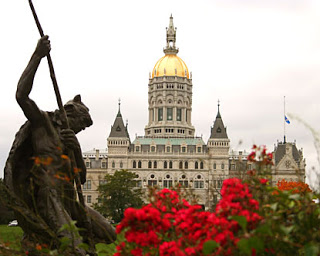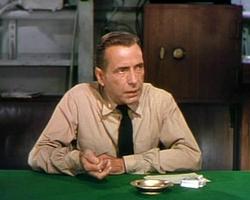
New York is not the only state turning to cultural heritage tourism or seeking to develop its historic community. Let’s look at our neighbor to the east and see what lessons we might learn from them.
Note – this post contains five items on what Connecticut is doing and four recommendations on what New York should do so it is too long to read on a computer at work in one sitting.
1. Colleges and State History
Walter W. Woodward, Associate Professor of History at the University of Connecticut and Connecticut State Historian, has sent a request to have students in Connecticut history classes sign-up for the a H-Connecticut list-serve (a moderated online discussion e-mail list) dedicated to that topic.
“Our list continues to grow and benefit from the amazing collective knowledge of our subscribers,” Woodward wrote in a recent e-mail. “It’s a great resource for anyone working on a topic related to Connecticut history, and I’d welcome requests from your colleagues or students. All they need to do to join is visit the H-Connecticut home page http://www.h-net.org/~ctlist/. click on the “Subscribe!” link on the left side of the page, and enter their email information.
New York does not have a comparable forum for communication.
2. Historic Organizations and a State Website
The Connecticut League of History Organizations, an organization roughly similar to Museumwise/MANY, is working with the Connecticut equivalent of New York Council for the Humanities to create a statewide website of local history stories that can be used by teachers and students. Obviously New York is much bigger so starting at the state-level might be too ambitious but regional implementation using a standardized format could be done. Here’s an excerpt from their announcement: “ConnecticutHistory.org, a project of Connecticut Humanities, is our state’s new online home for stories about the people, traditions, innovations, and events that make up our rich history. One of the core goals of ConnecticutHistory.org is to expose a broader audience to the resources and scholarship of the state’s history organizations. So, we are depending on you – our local experts – to help us build awareness of the unique and important histories that your collections tell.”
3. Regional Meetings of Historic Organizations
The Connecticut League of History Organizations (CLHO) is also holding mini-regional meetings in relation to new statewide website and to promote the development of the historical community by bringing people together in a informal and local setting. Museumwise/MANY has periodically held similar afternoon sessions in the upstate region, and the Association of Public Historians of New York State (APHNYS) is now looking to reinvigorate its regional format, and there are various independent regional meetings such as in New York City, western New York, and the Greater Hudson Valley.
Here’s an excerpt from their announcement: “You are welcome to come to any of the sessions that are convenient for you. Each two-hour meeting will include a welcome, introductions, a brief presentation by www.connecticuthistory.org, a new clearinghouse website designed to complement your organization’s existing online presence, and a brainstorming session of ideas for future meetings. You will leave knowing your “historical neighbors” just a little bit better, with potential dates and times set for a next meeting, and an awareness of new resources for our historical society and museum communities.”
4. State History Conference
The
Association for the Study of Connecticut History (a Connecticut state history organization roughly comparable to New York State Historical Association) is focusing on the War of 1812 at its annual conference. TheNew York State Historical Association had a track of sessions devoted to this topic as part of its larger and longer conference in Niagara this year.
An excerpt from the announcement: “The day-long conference will feature papers on various aspects of the War of 1812 to evaluate how the war transformed the political, economic and social landscape of Connecticut and New England. Topics will include individual events or people, as well as the wider economic, political, social, and cultural issues surrounding the war. Attendees will have the opportunity to tour the War of 1812 exhibit “The Rocket’s Red Glare” at the near-by Lyman Allyn Museum. For more the complete conference program and registration information, go to: http://asch-cthistory.org/fall-conference/.”
5. Tourism and State History
“Conversations at Connecticut’s Old State House” is a lunch-time conversation series held at the state capitol with this lecture addressing the state’s efforts in promoting history tourism. At one point, and possibly it still happens, these conversations on state history were broadcast which helped make history professors and authors mini-celebrities and gave state history a public face.
A recent Conversation was described in a press notice: “A conversation with Christopher ‘Kip’ Bergstrom, DECD Deputy Commissioner from the Office of Tourism and Culture. Recently the state launched the still revolutionary brand and spring/summer tourism campaign. What does the brand mean? What have been the results of the campaign so far? Join “Connecticut’s Ambassador” Diane Smith for a one-one conversation with Deputy Commissioner Bergstrom about Connecticut’s history of innovation, the power of Connecticut’s special places to inspire revolutionary thought and action, and an update on the initial results of the spring/summer marketing campaign.
To summarize, what can New York history community learn from Connecticut
1. To create a state list serve – the Connecticut one is moderated by the state historian but that does not necessarily have to be done in New York
2. To have co-ordinated regional regional meetings of historic sites – APHNYS is trying to do this with public historians and a similar effort should be undertaken with historic organizations. In addition to the state social studies conference there are some regional conferences but not covering all areas of the state. Since there also are archaeology conferences, canal conferences, and now Path through History meetings, just identifying all the relevant organizations and meeting would be a challenge. The regions of the Path through History project are one possible format and the county history conference is a more localized version.
3. To create a regular program of broadcasted capital conversations on New York history – I was recently interviewed, along with two other New Yorkers and one out-of-state scholar, by the PBS station in Albany on the War of 1812. Initially the hope was to broadcast it over Labor Day weekend but the editing was not completed in time. As a result the show will be aired over the Thanksgiving weekend. Why the delay? Normally the show covers Albany politics and holiday weekends are a downtime from history shows can be shown as filler. Why not have a weekly show on New York history in its own right?
4. To create a New York State history website – this is a truly gigantic undertaken both in size and scope. Various websites in this field have been created already. But if a teacher is looking for New York’s role in the Gilded Age or any other time period covered in the curriculum there is no one place to turn for the sites or the stories related to the topic. Tourists can use various websites to create itineraries for themselves for themselves with factual data but it is an effort. Given all that has been done in a fractured divided situation so far to create unity from division surely would be a challenge. Consider this a long-term goal that New York will never even seek to achieve because it is too demanding for a divided community.
Peter Feinman founder and president of the Institute of History, Archaeology, and Education, a non-profit organization which provides enrichment programs for schools, professional development program for teachers, public programs including leading Historyhostels and Teacherhostels to the historic sites in the state, promotes county history conferences and the more effective use of New York State Heritage Weekend and the Ramble.





